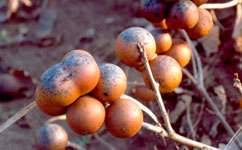British birds may be learning to use invasive wasps as key food source, research suggests

Biologists have found that blue tits, great tits and other native birds have learnt to peck away the tips of the galls formed by invading oak gall wasps and eat the juicy larvae inside, which are rich in protein. This helps them survive the crucial early spring period, when other food is scarce.
The new food source could help counteract the effects of climate change, which is causing some birds to lay their eggs too early in the year. The young then hatch before their main food - caterpillars that feed on oak leaves - becomes available.
'What is exciting is that we've shown that the gall wasps are a really significant food source, and not just an occasional snack,' says Professor Graham Stone of the University of Edinburgh, who worked with Dr Karsten Schönrogge of the Centre for Ecology & Hydrology on the study.
The tiny alien gall wasps, just 1-2mm long, have a weird and wonderful lifecycle. After mating, females lay their eggs in the buds of native British oaks in early summer. The larvae produce chemicals that make protective galls grow around them. But the wasps that emerge are all female, and reproduce without mating. They lay their eggs in the buds of the Turkey oak, which was introduced to Britain about 300 years ago. Turkey oak galls grow over winter and early spring, with each tree carrying many thousands of galls. Both males and females hatch from these galls, and the cycle then starts over again.
The research involved a heroic effort by PhD student (now Dr) Tracey Begg, who cut open over 30,000 Turkey oak buds gathered from eight sites in England and Scotland. She counted how many of the 3,000 galls she found had a ragged hole that showed they had been attacked by birds, instead of the smooth hole left when wasps emerge naturally. On some trees, around half had peck-marks - a very high attack rate.
The team found that at some sites, a higher proportion had been attacked on the trees that had more galls, showing that birds were choosing to spend more time feeding on gall-rich trees. 'They wouldn't do that if the galls weren't an important source of food,' explains Stone. 'Of course, it could be that there is some manic great tit eating all the galls, but it is far more likely that this is a response by the whole population.'
This pattern was strongest at two sites in southern England, where the invasive wasps first arrived. The researchers think that this is because the birds take time to learn to find the larvae. They already eat the larvae of native gall wasps, but these live in galls that look quite different, such as the familiar brown 'oak apples' on native oaks.
In contrast, the alien galls are just 2-3mm long and are hidden inside the buds of the non-native Turkey oak. Birds may also take time to learn which trees have more galls, as some seem to be much more susceptible to gall formation than others. Quick learners may be rewarded, as more invaders that depend on the Turkey oak are arriving in the UK, including the gooseberry gall wasp Andricus grossulariae.
Although the alien gall wasps studied in this project are relatively harmless, the researchers are also involved in a big European project looking at more dangerous invaders. 'There is one gall wasp moving up through Europe, which has not reached Britain yet, which could cause serious problems,' explains Stone. 'The chestnut gall wasp, which was introduced to Italy from China in about 2000, can kill chestnut trees and destroy the crop. In Italy, imported Japanese parasitoid wasps as well as some native parasitoids are starting to kill it - the big question is whether they can do it quickly enough.'
More information: Schönrogge K, Begg T, Stone GN (2013) Native Birds and Alien Insects: Spatial Density Dependence in Songbird Predation of Invading Oak Gallwasps. PLoS ONE 8(1): e53959. doi:10.1371/journal.pone.0053959
Journal information: PLoS ONE
Provided by PlanetEarth Online
This story is republished courtesy of Planet Earth online, a free, companion website to the award-winning magazine Planet Earth published and funded by the Natural Environment Research Council (NERC).













.jpg)






